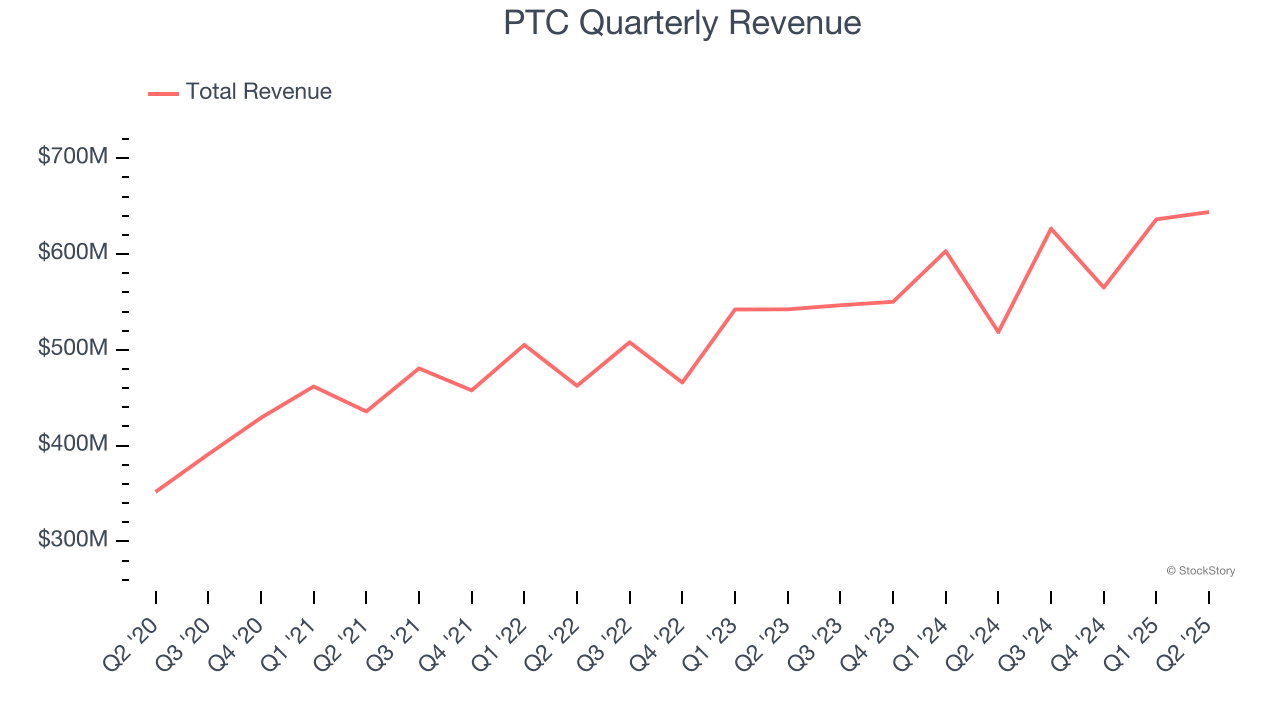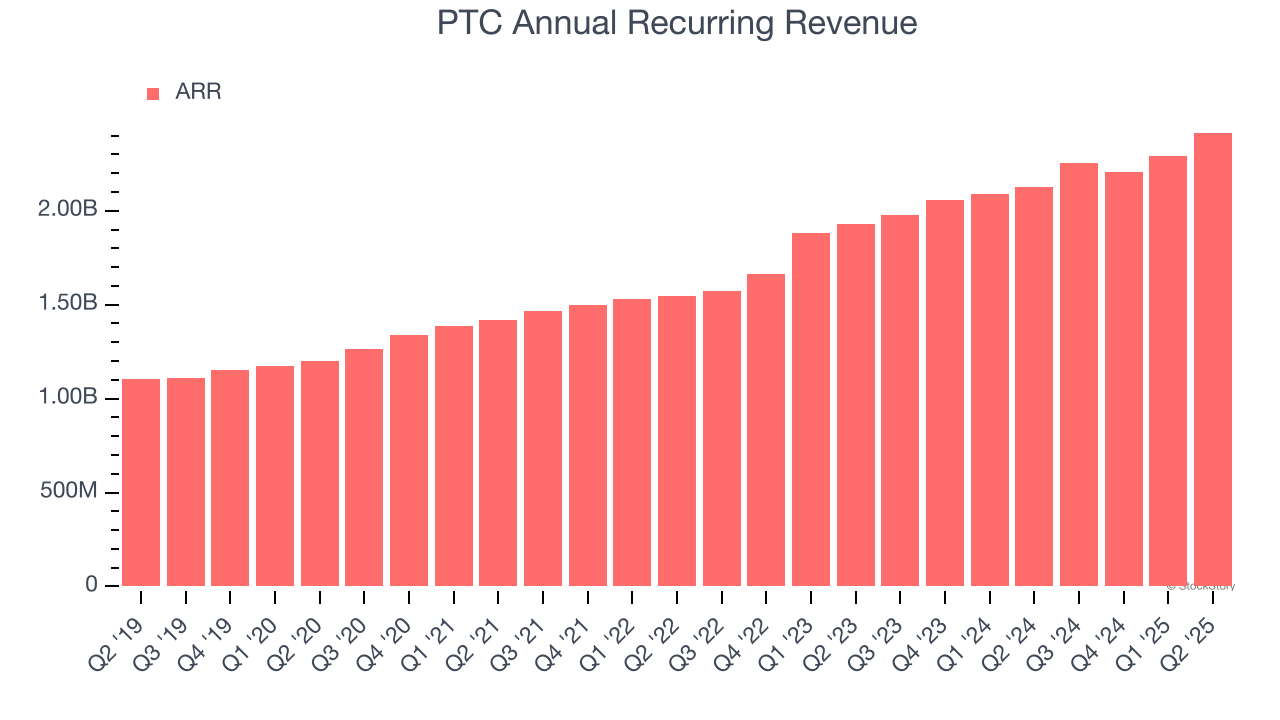
Engineering and design software provider PTC (NASDAQ: PTC) reported Q2 CY2025 results exceeding the market’s revenue expectations, with sales up 24.2% year on year to $643.9 million. On top of that, next quarter’s revenue guidance ($755 million at the midpoint) was surprisingly good and 5.6% above what analysts were expecting. Its GAAP profit of $1.17 per share was 45.8% above analysts’ consensus estimates.
Is now the time to buy PTC? Find out by accessing our full research report, it’s free.
PTC (PTC) Q2 CY2025 Highlights:
- Revenue: $643.9 million vs analyst estimates of $583.3 million (24.2% year-on-year growth, 10.4% beat)
- EPS (GAAP): $1.17 vs analyst estimates of $0.80 (45.8% beat)
- Adjusted Operating Income: $285.2 million vs analyst estimates of $212.6 million (44.3% margin, 34.1% beat)
- Revenue Guidance for Q3 CY2025 is $755 million at the midpoint, above analyst estimates of $714.7 million
- Operating Margin: 32.6%, up from 18.5% in the same quarter last year
- Free Cash Flow Margin: 0%, down from 43.8% in the previous quarter
- Annual Recurring Revenue: $2.42 billion at quarter end, up 13.6% year on year
- Billings: $592.9 million at quarter end, up 22% year on year
- Market Capitalization: $24.49 billion
"Q3 was another solid quarter of execution for PTC. Our strategy of enabling product data foundations and extending the value of that data across the enterprise is resonating with customers across our verticals and geographies," said Neil Barua, President and CEO, PTC.
Company Overview
Used to design the Airbus A380 and Boeing 787 Dreamliner commercial airplanes, PTC’s (NASDAQ: PTC) software-as-service platform helps engineers and designers create and test products before manufacturing.
Revenue Growth
A company’s long-term sales performance can indicate its overall quality. Any business can have short-term success, but a top-tier one grows for years. Unfortunately, PTC’s 9.1% annualized revenue growth over the last three years was sluggish. This fell short of our benchmark for the software sector and is a tough starting point for our analysis.

This quarter, PTC reported robust year-on-year revenue growth of 24.2%, and its $643.9 million of revenue topped Wall Street estimates by 10.4%. Company management is currently guiding for a 20.5% year-on-year increase in sales next quarter.
Looking further ahead, sell-side analysts expect revenue to grow 8.8% over the next 12 months, similar to its three-year rate. This projection doesn't excite us and indicates its newer products and services will not accelerate its top-line performance yet.
Unless you’ve been living under a rock, it should be obvious by now that generative AI is going to have a huge impact on how large corporations do business. While Nvidia and AMD are trading close to all-time highs, we prefer a lesser-known (but still profitable) stock benefiting from the rise of AI. Click here to access our free report one of our favorites growth stories.
Annual Recurring Revenue
While reported revenue for a software company can include low-margin items like implementation fees, annual recurring revenue (ARR) is a sum of the next 12 months of contracted revenue purely from software subscriptions, or the high-margin, predictable revenue streams that make SaaS businesses so valuable.
PTC’s ARR punched in at $2.42 billion in Q2, and over the last four quarters, its growth slightly outpaced the sector as it averaged 11.1% year-on-year increases. This performance aligned with its total sales growth and shows the company is securing longer-term commitments. Its growth also contributes positively to PTC’s revenue predictability, a trait long-term investors typically prefer. 
Customer Acquisition Efficiency
The customer acquisition cost (CAC) payback period represents the months required to recover the cost of acquiring a new customer. Essentially, it’s the break-even point for sales and marketing investments. A shorter CAC payback period is ideal, as it implies better returns on investment and business scalability.
PTC is extremely efficient at acquiring new customers, and its CAC payback period checked in at 15.9 months this quarter. The company’s rapid recovery of its customer acquisition costs indicates it has a highly differentiated product offering and a strong brand reputation. These dynamics give PTC more resources to pursue new product initiatives while maintaining the flexibility to increase its sales and marketing investments.
Key Takeaways from PTC’s Q2 Results
We were impressed by how significantly PTC blew past analysts’ revenue, EPS, and adjusted operating income expectations this quarter. We were also glad its revenue guidance for next quarter exceeded Wall Street’s estimates. Zooming out, we think this quarter featured some important positives. The stock traded up 8.2% to $219.99 immediately following the results.
PTC had an encouraging quarter, but one earnings result doesn’t necessarily make the stock a buy. Let’s see if this is a good investment. We think that the latest quarter is only one piece of the longer-term business quality puzzle. Quality, when combined with valuation, can help determine if the stock is a buy. We cover that in our actionable full research report which you can read here, it’s free.





